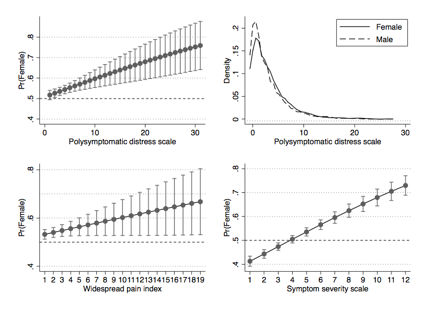Session Information
Date: Monday, October 22, 2018
Title: 4M082 ACR Abstract: Fibromyalgia & Other Clinical Pain Syndromes (1834–1839)
Session Type: ACR Concurrent Abstract Session
Session Time: 2:30PM-4:00PM
Background/Purpose: Multiple clinical and epidemiological studies have provided estimates of fibromyalgia prevalence and sex ratio, but different criteria sets and methodology, as well as bias, have led to widely varying (0.4%->11%) estimates of prevalence and female predominance (>90% to <61%). In general, studies have failed to distinguish Criteria based fibromyalgia (CritFM) from Clinical fibromyalgia (ClinFM) or fibromyalgia diagnosed by clinicians. In the current study we compare CritFM with ClinFM to investigate gender and other biases in the diagnosis of fibromyalgia.
Methods: We used a rheumatic disease databank and 2016 fibromyalgia criteria to study prevalence and sex ratios in a selection biased sample of 1761 referred and diagnosed fibromyalgia patients and in an unbiased sample of 4342 patients with no diagnosis with respect to fibromyalgia. We compared diagnostic and clinical variables according to gender, and we reanalyzed a German population study (GPS) (n=2435) using revised 2016 criteria for fibromyalgia.
Results: In the selection-biased sample of referred patients with fibromyalgia, more than 90% were women. However, when an unselected sample of rheumatoid arthritis (RA) patients was studied for the presence of fibromyalgia, women represented 58.7% of fibromyalgia cases. Women had slightly more symptoms than men, including generalized pain (36.8% vs. 32.4%), count of 37 symptoms (4.7 vs. 3.7) and mean polysymptomatic distress score (10.2 vs. 8.2), and we found a linear relation between the probability of being females and fibromyalgia and fibromyalgia severity – as shown in the figure below. Women in the GPS represented 59.2% of cases.
Conclusion: The perception of fibromyalgia as almost exclusively (90% or greater) a disorder of women is not supported by data in unbiased studies. Using validated self-report criteria and unbiased selection, the female proportion of fibromyalgia cases was less than or equal to 60% in the unbiased studies, and the observed CritFM prevalence of fibromyalgia in the GPS was approximately 2%. ClinFM is the public face of fibromyalgia, but is severely affected by selection and confirmation bias in the clinic and publications, underestimating men with fibromyalgia and overestimating women. We recommend the use of 2016 fibromyalgia criteria for clinical diagnosis and epidemiology because of its updated scoring and generalized pain requirement. Fibromyalgia and generalized pain positivity, widespread pain (WPI), symptom severity scale (SSS) and polysymptomatic distress (PSD) scale should always be reported in order to adequately characterize subjects in fibromyalgia studies.
To cite this abstract in AMA style:
Walitt B, Wolfe F, Perrot S, Rasker J, Häuser W. Fibromyalgia Diagnosis and Biased Assessment: Sex, Prevalence, Biology and Bias [abstract]. Arthritis Rheumatol. 2018; 70 (suppl 9). https://acrabstracts.org/abstract/fibromyalgia-diagnosis-and-biased-assessment-sex-prevalence-biology-and-bias/. Accessed .« Back to 2018 ACR/ARHP Annual Meeting
ACR Meeting Abstracts - https://acrabstracts.org/abstract/fibromyalgia-diagnosis-and-biased-assessment-sex-prevalence-biology-and-bias/

